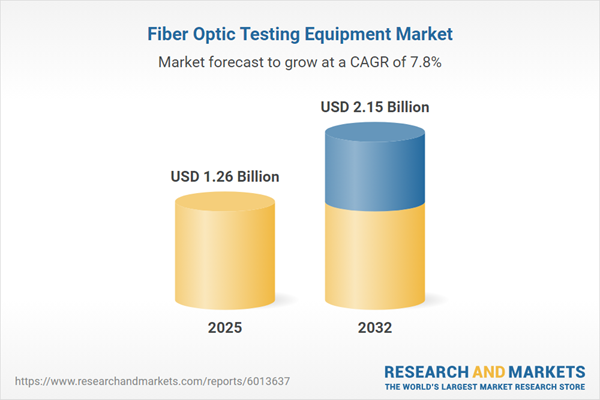Speak directly to the analyst to clarify any post sales queries you may have.
The fiber optic testing equipment market is evolving rapidly as enterprises and network providers increasingly demand reliable, high-precision validation tools to support today’s advanced digital infrastructure needs.
Market Snapshot: Fiber Optic Testing Equipment Market Overview
The Fiber Optic Testing Equipment Market grew from USD 1.17 billion in 2024 to USD 1.26 billion in 2025. It is expected to continue growing at a CAGR of 7.84%, reaching USD 2.15 billion by 2032. This growth highlights the expanding role of fiber optic testing equipment in supporting next-generation networks, stringent regulatory expectations, and increasing demand for high-speed, resilient data transmission across global industries.
Scope & Segmentation
This research provides an in-depth analysis of market drivers, emerging technologies, and competitive shifts shaping the global fiber optic testing equipment landscape across key segments:
- Equipment Types: Optical light sources, optical power and loss meters, spectrum analyzers, time domain reflectometers, and remote fiber test systems.
- Fiber Modes: Multi mode and single mode configurations supporting different network requirements from short-range enterprise installations to long-haul infrastructure.
- Form Factors: Bench top systems for lab environments and handheld units for field deployment, ensuring both precision and operational flexibility.
- End Users: Data centers, enterprise IT, telecommunications operators, military and aerospace programs, and oil and gas operations requiring tailored solution sets and compliance assurance.
- Distribution Channels: Direct sales, distributor networks, and online platforms facilitating customer access, aftersales support, and aftermarket services.
- Regions: Americas, Europe, Middle East & Africa, and Asia-Pacific, with further detail on leading national and sub-regional markets.
Key Takeaways for Senior Decision-Makers
- Next-generation networks like 5G and edge computing have accelerated demand for adaptive, modular fiber testing architectures capable of integrating new protocols and supporting predictive analytics.
- Market participants across regions are prioritizing agility through cloud-enabled monitoring, remote diagnostics, and compact, battery-powered solutions suited for decentralized network topologies.
- Rising regulation and sustainability mandates drive adoption of high-precision, low-power equipment and highlight the strategic value of compliance-ready platforms and integrated analytics.
- End users seek comprehensive validation workflows, driving suppliers to expand service offerings with bundled maintenance, calibration, and lifecycle management.
- Channel diversification and digital sales platforms broaden reach, while adaptive sourcing and innovative leasing or as-a-service models support cost containment and technology refresh cycles.
Tariff Impact and Supply Chain Adaptation
Recent tariff adjustments in the United States have prompted manufacturers and distributors to diversify their supply chains, optimize operational footprints, and develop new procurement and financial models. The shift toward leasing and subscription-based access allows organizations to deploy advanced testing solutions while navigating cost and compliance pressures. Enhanced collaboration between domestic suppliers and global producers is fostering development of alternative components and regional assembly centers.
Methodology & Data Sources
This analysis integrates primary research from executive and end-user interviews with comprehensive secondary data from industry reports, regulatory filings, and financial disclosures. Triangulation methods validate data integrity, while competitive intelligence and peer review refine market insights for robust decision support.
Why This Report Matters
- Enables executives to benchmark technology adoption and make informed investment decisions in fiber optic testing solutions.
- Provides clarity on compliance, supply chain resilience, and service models vital for network upgrades or expansions.
- Equips teams with actionable insights into regional demand shifts, innovation trajectories, and emerging partnership opportunities.
Conclusion
The fiber optic testing equipment market is defined by innovation, adaptability, and a strong focus on reliability across diverse sectors. Targeted investment in modular solutions and robust partnerships will enable stakeholders to meet the evolving needs of modern connectivity with confidence.
Additional Product Information:
- Purchase of this report includes 1 year online access with quarterly updates.
- This report can be updated on request. Please contact our Customer Experience team using the Ask a Question widget on our website.
Table of Contents
3. Executive Summary
4. Market Overview
7. Cumulative Impact of Artificial Intelligence 2025
Companies Mentioned
The companies profiled in this Fiber Optic Testing Equipment market report include:- AFL Global by Fujikura, Ltd
- Anritsu Corporation
- Corning Incorporated
- Deviser Instruments
- Fluke Networks by Danaher Corporation
- GAO Tek Inc.
- Greenlee Communications
- Keysight Technologies, Inc
- Kingfisher International by Tempo Communications
- Luna Innovations Incorporated
- Santec Corporation
- PROMAX Electronica
- SENKO Advanced Components, Inc.
- Thorlabs, Inc.
- VeEX Inc.
- Viavi Solutions Inc.
- Yokogawa Electric Corporation
- Torontech Inc.
- Terahertz Technologies Inc. by TREND Networks
- OZ Optics Ltd.
- Jonard Tools
Table Information
| Report Attribute | Details |
|---|---|
| No. of Pages | 190 |
| Published | November 2025 |
| Forecast Period | 2025 - 2032 |
| Estimated Market Value ( USD | $ 1.26 Billion |
| Forecasted Market Value ( USD | $ 2.15 Billion |
| Compound Annual Growth Rate | 7.8% |
| Regions Covered | Global |
| No. of Companies Mentioned | 22 |









